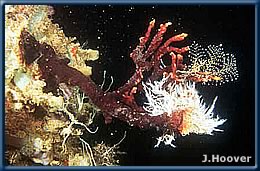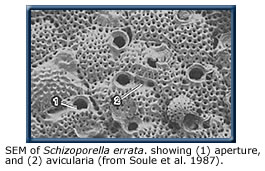

Schizoporella errata

Amathia distans

Bugula neritina
Schizoporella cf. errata
 Branching
bryozoan
Branching
bryozoan
Phylum Ectoprocta
Class Gymnolaemata
Order Cheilostomata
Family Schizoporellidae
Description
This heavily calcified encrusting bryozoan is typically dark brick red
with orange-red growing margins. It assumes the shape of whatever it overgrows.
This species may form heavy knobby incrustations on flexible surfaces
such as algae or worm tubes, turning them into solid, sometimes erect
branching structures. The thickness of the growth is dependent upon the
age of the colony. Multilaminar encrustations of 1 cm thick are common.
The frontal surface of the zoecium (secreted exoskeleton housing of individual
zooids) is porous with a wide semicircular aperture and proximal sinus.
Also with single avicularia on right or left side of aperture sinus.
Habitat
 As
fouling in shallow water on hard substrates (pilings, hulls, coral rubble,
etc.) in harbors and embayments. Occasionally found on the reef, especially
in Kaneohe Bay.
As
fouling in shallow water on hard substrates (pilings, hulls, coral rubble,
etc.) in harbors and embayments. Occasionally found on the reef, especially
in Kaneohe Bay.
Distribution
Hawaiian Islands
Throughout the main islands and Midway Atoll.
Native Range
Mediterranean
Present Distribution
Probably worldwide in warm temperate-subtropical seas (reported from West
Africa, Red Sea, Persian Gulf, South Australia, New Zealand, Hawaiian
Islands, Pacific Coast of North America, East Coast North America through
Caribbean to Brazil, and Mediterranean).
Mechanism of Introduction
Unintentional, as fouling on ships' hulls
Impact
Fouling organism. Ecological impact unstudied, but observations suggest
some competition for space with other fouling invertebrates.
Ecology
Feeding
The bryozoan is a suspension feeder. It has a retractable U-shaped crown
of tentacles (lophophore) which bear cilia that create a current, bringing
food particles toward the animal. Particles are then guided into the mouth
by action of the tentacles and cilia.
Reproduction
Each bryozoan colony begins from a single, sexually produced, primary
zooid. This zooid undergoes asexual budding to produce a group of daughter
cells, which themselves form buds, and so on. Most bryozoans are hermaphroditic,
each zooid capable of producing sperm and eggs. Sperm is released into
the coelom and the fertilized eggs are retained and brooded for a time
before being released.
Remarks
Edmondson (1933) was the first to remark upon an "undetermined orange
species" forming encrustitng and branching colonies in Pearl Harbor.
Often reported as Schizoporella errata, it
is now a common fouling species, found throughout the main Islands.
References
Soule, J.D., D.F. Soule, and H.W.Chaney. 1987. Phylum Ectoprocta. in Reef
and Shore Fauna of Hawaii. Section 2: Platyhelminthes through Phoronida,
and Section 3: Sipuncula through Annelida, D. Devaney and L. Eldredge,
eds. Bishop Mus. Spec. Pub. 64(2 and 3): 83-166.
Edmonson, C.H. 1933. Reef and Shore Fauna of Hawaii. B.P. Bishop Mus.
Spec. Pub. 22.
© 2002 Hawaii Biological Survey, Bishop Museum
contact